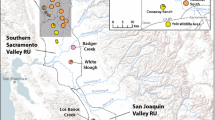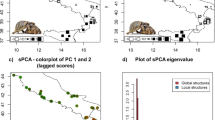Abstract
The gopher tortoise (Gopherus polyphemus) is an important member of the sandhill, longleaf pine, and scrub ecosystems in the southeastern United States. Even though it is currently protected throughout its range, tortoise populations continue to decline. We assessed genetic diversity at nine microsatellite loci in 300 individuals from 21 locations throughout Florida and southern Georgia. Tortoise populations are clearly subdivided into at least eight genetic assemblages with an \(\bar{F}_{\rm ST}=0.24\pm 0.11\). Furthermore, we found indications of anthropogenic effects in the form of population bottlenecks in five populations and putative admixture in four. From these data, we recommend that the populations be managed to maintain existing genetic structure without further isolation of populations and the establishment of a holistic␣database to include genetic and demographic information useful for relocation and management purposes.
Similar content being viewed by others
References
Auffenberg W, Franz R (1982) The status and distribution of the gopher tortoise (Gopherus polyphemus). In: North American Tortoises: Conservation and Ecology, pp. 95–126. Wildlife Research Report 12. U.S. Fish and Wildlife, Service, Washington, D.C
Branch LC, Clark AM, Bowen BW (2003) Fragmented landscapes, habitat specificity, and conservation genetics of three lizards in Florida scrub. Conserv. Genet. 4:199–212
Brown MB, McLaughlin GS, Klein PA, Crenshaw BC, Schumacher IM, Brown DR, Jacobson ER (1999) Upper respiratory tract disease in the gopher tortoise is caused by Mycoplasma agassizii. J. Clin. Microbiol. 37: 2262–2269
Bureau of Economic and Business Research (2000) Florida Statistical Abstract. University Presses of Florida, Gainesville
Clark AM, Bowen BW, Branch LC (1999) Effects of natural habitat fragmentation on an endemic scrub lizard (Sceloporus woodi): an historical perspective based on a mitochondrial DNA gene genealogy. Mol. Ecol. 8: 1093–1104
Cornuet JM, Luikart G (1996) Description and power analysis of two tests for detecting recent population bottlenecks from allele frequency data. Genetics 144: 2001–2014
Crandall KA, Bininda-Emonds ORP, Mace GM, Wayne RK (2000) Considering evolutionary processes in conservation biology. Trends Ecol. Evol. 15: 290–295
Diemer Berish JE, Wendland LD, Gates CA (2000) Distribution and prevalence of upper respiratory tract disease in gopher tortoises in Florida. J. Herpetol. 34: 5–12
Diemer JE (1986) The ecology and management of the gopher tortoise in the southeastern United States. Herpetologica, 42, 125–133
Diemer JE (1992) Home range and movements of the tortoise Gopherus polyphemus in northern Florida. J. Herpetol. 26:158–165
Dudash M, Fenster CB (2000) Inbreeding and outbreeding depression in fragmented population. In: Clarke GM (eds). Genetics, Demography and Viability of Fragmented Populations. Cambridge University Press, New York
Eubanks JO, Michener WK, Guyer C (2003) Patterns of movements and burrow use in a population of gopher tortoises (Gopherus polyphemus). Herpetologica 59: 311–321
Excoffier L, Smouse PE, Quattro JM (1992) Analysis of molecular variance inferred from metric distances among DNA haplotypes: Application to human mitochondrial DNA restriction data. Genetics 131: 479–491
Florida Fish and Wildlife Conservation Commission (2001) Available options to address the presence of gopher tortoises on lands slated for development. Available at http://wildflorida.org/permits/permits.html#gophertortoise. Accession date 27 April 2005
Florida Fish and Wildlife Conservation Commission (2005) Florida’s endangered species, threatened species, and species of special concern. Available at http://www.wildflorida.org/imperiled/default.htm. Accession date 27 April 2005
Gaggiotti OE, Lange O, Rassmann K, Gliddon C (1999) A comparison of two indirect methods for estimating average levels of gene flow using microsatellite data. Mol. Ecol., 8, 1513–1520
Gilpin ME, Soulé ME (1986) Minimum viable populations; processes of species extinction. In: Soulé ME (eds). Conservation Biology. Sinauer Associates, Inc., Sunderland, Massachusetts, pp. 19–34
Guo SW, Thompson EA (1992) Performing the exact test of Hardy-Weinberg proportion for multiple alleles. Biometrics 48: 361–372
Harrison S, Bruna EM (1999) Habitat fragmentation and large-scale conservation: what do we know for sure?. Ecography 22: 225–232
Hedrick PW (1983) Genetics of Populations. Science Books International, Portola Valley, CA
Hermann SM, Guyer C, Waddle JH, Nelms MG (2002) Sampling on private property to evaluate population status and effects of land use practices on the gopher tortoise, Gopherus polyphemus. Biol. Conserv. 108: 289–298
Herrmann BG, Frischauf A (1987) Isolation of genomic DNA. Methods Enzymol. 152: 180–182
Inskipp T, Gillett HJ Eds. (2003) Checklist of CITES Species. Compiled by UNEP-WCMC, CITES Secretariat, Geneva, Switzerland and UNEP-WCMC, Cambridge, UK
Karl SA, Bowen BW, Avise JC (1992) Global population genetic structure and male-mediated gene flow in the green sea turtle (Chelonia mydas): RFLP analysis of anonymous nuclear loci. Genetics 131: 163–173
Kautz RS (1993) Trends in Florida wildlife habitat 1939–1987. Conservation Science 57: 7–24
Kent DM, Langston MA, Hanf DW (1997) Observations of vertebrates associated with gopher tortoise burrows in Orange County, Florida. Florida Sci. 60: 193–196
Lande R, Barrowclough GF (1987) Effective population size, genetic variation, and their use in population management. In: Soulé ME (eds). Viable Populations for Conservation. Cambridge University Press, Cambridge, pp. 87–123
Lips KR (1991) Vertebrates associated with tortoise (Gopherus polyphemus) burrows in four habitats in south-central Florida. J. Herpetol. 25: 477–481
Luikart G, Cornuet JM (1998) Empirical evaluation of a test for identifying recently bottlenecked populations from allele frequency data. Conserv. Biol. 12: 228–237
Luikart G, Sherwin WB, Steele BM, Allendorf FW (1998) Usefulness of molecular markers for detecting population bottlenecks via monitoring genetic change. Mol. Ecol. 7: 963–974
Macdonald LA, Mushinsky HR (1988) Foraging ecology of the gopher tortoise, Gopherus-polyphemus, in a sandhill habitat. Herpetologica 44: 345–353
McDonald DB, Potts WK, Fitzpatrick JW, Woolfenden GE (1999) Contrasting genetic structures in sister species of North America scrub-jays. Proc. Roy. Soc. London Ser. B 266: 1117–1125
McRae WA, Landers JL, Garner JA (1981) Movement patterns and home range of the gopher tortoise. Am. Midland Nat. 106: 165–179
Moritz C (1999) Conservation units and translocations: strategies for conserving evolutionary processes. Hereditas 130: 217–228
Moritz C (2002) Strategies to protect biological diversity and the evolutionary processes that sustain it. Syst. Biol. 51: 238–254
Noss RF (1989) Longleaf pine and wiregrass: Keystone components of an endangered ecosystem. Nat. Areas J. 9: 211–213
Noss RF, LaRoe ET, III, Scott JM (1995) Endangered Ecosystems of the United States: A Preliminary Assessment of Loss and Degradation, Biological Report 28. U. S. Department of Interior, National Biological Service, Washington, D. C
Opkyke ND, Spangler DP, Smith DL, Jones DS, Lindquist RC (1984) Origin of the epeirogentic uplift of Pliocene-Pleistocene beach ridges in Florida and development of the Florida karst. Geology 12: 226–228
Osentoski MF, Lamb T (1995) Intraspecific phylogeography of the gopher tortoise, Gopherus polyphemus: RFLP analysis of amplified mtDNA segments. Mol. Ecol. 4: 709–718
Piry S, Luikart G, Cornuet JM (1999) BOTTLENECK: A computer program for detecting recent reductions in the effective population size using allele frequency data. J. Hered. 90: 502–503
Pritchard JK, Stephens M, Donnelly P (2000) Inference of population structure using multilocus genotype data. Genetics 155: 945–959
Raymond M, Rousset F (1985) GENEPOP v. 1.2: population genetics software for exact tests and ecumenicism. J. Hered. 83: 239
Rhymer JM, Simberloff D (1996) Extinction by hybridization and introgression. Annu. Rev. Ecol. Syst. 27: 83–109
Rice WR (1989) Analyzing tables of statistical tests. Evolution 43: 223–225
Ryder OA (1986) Species conservation and systematics: the dilemma of subspecies. Trends Ecol. Evol. 1: 9–10
Schneider S, Roessli D, Excoffier L (2002) Arlequin ver. 2.000: A Software for Population Genetics Data Analysis. Genetics and Biometry Laboratory, University of Geneva, Switzerland
Schwartz TS, Karl SA (2003) Microsatellite loci for the North American tortoises (genus Gopherus) and their applicability to other turtle species. Mol. Ecol. Notes 3: 283–286
Sherwin WB, Moritz C (2000) Managing and monitoring genetic erosion. In: Clarke GM (eds). Genetics, Demography and Viability of Fragmented Populations. Cambridge University Press, New York, pp. 9–34
Slatkin M (1995) A measure of population subdivision based on microsatellite allele frequencies. Genetics 139: 457–462
Slatkin M, Excoffier L (1996) Testing for linkage disequilibrium in genotypic data using the Expectation-Maximization algorithm. Heredity 76: 377–383
Templeton AR (1986) Coadaptation and outbreeding depression. In: Soulé ME (eds). Conservation Biology. Sinauer Associates, Inc., Sunderland, Massachusetts, pp. 105–116
Waples RS (1991) Pacific salmon, Oncorhynuchus spp., and the definition of ‘species’ under the endangered species act. Marine Fish. Rev. 53:11–22
Webb SD (1990) Historical biogeography. In: Ewel JJ (eds). Ecosystems of Florida. University of Central Florida Press, Orlando, Florida, pp. 70–102
Witz BW, Wilson DS, Palmer MD (1991) Distribution of Gopherus polyphemus and its vertebrate symbionts in three burrow categories. American Midland Naturalist 126: 152–158
Wright S (1969) Evolution and the Genetics of Populations: Volume 2. The Theory of Gene Frequencies. University of Chicago Press, Chicago
Acknowledgements
A. Bass, R. Brachmann, C. Curtis, K. Hayes, C. Legler, K. Penney, M. Smith, and D. Warner assisted in the collection of samples. R. Ashton, R. Birkhead, T. Lamb, M. Lockhart, E. McCoy, H. Mushinsky, M. Osentoski, S. Reidel, K. Stiles, T. Tuberville and L. Wendland generously provided samples. A. Bass, C. Curtis, T. Engstrom, K. Hayes, E. Severance, E. McCoy, H. Mushinsky, D. Warner, M. Zacks, and three anonymous reviewers provided helpful and greatly appreciated comments on the manuscript. This project was funded in part by the Chelonian Research Foundation Linneaus Fund, Sigma Delta Xi Women in Science, Eloise Gerry Fellowship, and a University of South Florida Tharpe Fellowship to TS and by Arcadia Wildlife Preserve, Inc. and a National Science Foundation Grant in Systematics DEB 98-06905 to SAK.
Author information
Authors and Affiliations
Corresponding author
Rights and permissions
About this article
Cite this article
Schwartz, T.S., Karl, S.A. Population and conservation genetics of the gopher tortoise (Gopherus polyphemus). Conserv Genet 6, 917–928 (2005). https://doi.org/10.1007/s10592-005-9078-5
Received:
Accepted:
Published:
Issue Date:
DOI: https://doi.org/10.1007/s10592-005-9078-5




